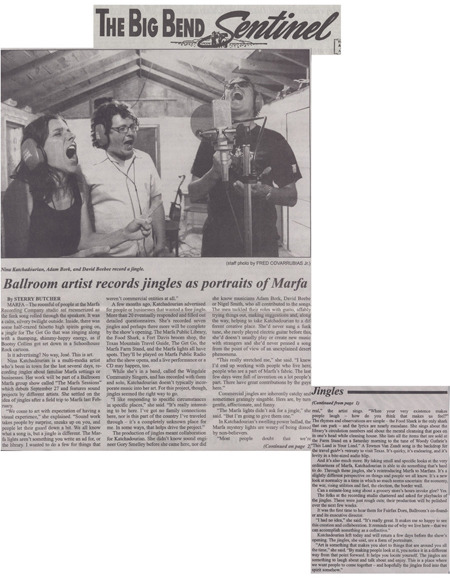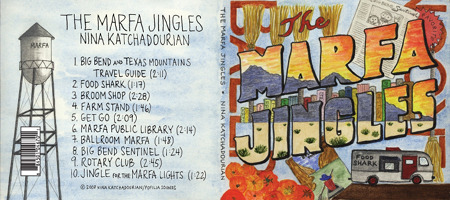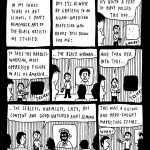Special Feature: A Conversation with Nina Katchadourian
Suzan Sherman: In the past your work has focused on the natural world, and toying with the intricate and seemingly set systems within that world. But for this project, The Marfa Jingles, you’ve honed in on Marfa, Texas—the systems of shops and business and organizations that are this tiny town’s glue. Like some of your other work, your jingles seem to be an attempt at organizing and arranging (you’re literally arranged the music and the lyrics for them). At the same time, I would have never expected you to come up with a project of writing and producing a series of audio advertisements. How did this idea come about for you?
Nina Katchadourian: I’m often looking at the natural world, but just as often I’m looking at the human and social world. The Marfa Jingles looks at the town as a social structure—as a place where people live, work, and run businesses and organizations. I’ve kind of collected Marfa, and used the project as a vehicle to get to know the town. I think of it as not so far from my project Office Semaphore, and other public pieces that I’ve done that look at the rather mundane fixtures of everyday life. The jingles I’ve made are now being played on Marfa Public Radio—they’re in the public space, which is on the airwaves, where the people of Marfa and all of west Texas can hear this stuff.
And although I do use the term jingle, which is a form that we associate with advertising, when you hear the songs I think that it becomes evident that they aren’t ads at all. I’m using the term very loosely. The jingles are more like little sound-songs portraits of various public-service clubs, organizations, and stores. I’m doing something that when taken collectively provides a cross-section of this tiny place in Texas. I don’t really feel like I’ve been writing advertising; I feel like I’ve been writing songs and cross-pollinating them with the jingle form.
SS: Have you received any feedback from their being on the radio?
NK: Before they even went on the air, when the jingles were done, I sent them to all of my customers. I wanted to know what they thought and to make sure they were OK with it. Everyone has been incredibly positive.
SS: You just used the word customer, and I hadn’t thought about The Marfa Jinglesas something that you provide as a service for someone, or by extension, for a community. It makes me think of your earlier work where you attempt to mend spider’s webs. On some level, do you think of these jingles as another attempt at gift-giving?
NK: I suppose the fact that they are free is something that runs contrary to the traditional form of jingles as advertising. In fact, I got one email from someone who asked a bit suspiciously “why are the jingles free?” and I had to explain that project was being done as part of an art exhibition. It did highlight the fact that as consumers we raise our eyebrows somewhat when confronted with a situation that seems “too good to be true.” Like there had to be a catch. I think of the jingles not so much as a gift, but as an opportunity for two parties involved: my “customer,” who gets some free promotion in a song form that they hopefully like and find memorable and that appeals to the public, and for me it’s chance to talk to them, and learn about Marfa through them. There is generosity involved in both our roles, is the way that I see it.
SS: There’s lot of specific details in your lyrics, such as that the Marfa Public Library circulates 34,993 items per year. Did you speak to shopkeepers in person or on the phone to obtain this information?
NK: I made a very concerted attempt to gather real data before writing the songs, and they’re meant to function as things that impart real and important information, such as what hours a store is open. At the same time, I wanted them to be interesting as songs. What I did initially was put out the word in Marfa that there was an opportunity to have a jingle written for free that would air on the radio. I sent out a questionnaire to those people who were interested, and asked them about who they are, what their business organization is, and what they wanted me to emphasize in the jingle. Sometimes they provided details about themselves and their lives that were relevant, and I also asked if they had a musical style they wanted me to try to work in.
From the very beginning, the jingles were intended to be aired on the radio. That’s always been the final place that they were going to end up. Because there was a lot of enthusiasm about the project, Marfa Ballroom ultimately decided that we would make a CD. For the sound show, The Marfa Sessions, they’ll be a little listening station inside of the Ballroom Marfa space as well as documentation—a wall of notes, lyrics, and emails; all of the things that led up to it.

SS: I love the “Food Shark” jingle. It reminds me of a B52s tune. And your sweet jingle about the Marfa Public Library feels a bit Free to Be…You and Me. You’ve covered an incredible range of musical genres. What served as your inspiration?
NK: I let the information that I gathered take the lead. And sometimes someone, like the woman who I ended up doing a jingle for the Big Bend Texas Mountain and Travel Guide, said, “I’m a huge fan of Townes Van Zandt, so could you make a jingle like Townes Van Zandt?” So that jingle is strongly influenced by one of his tunes. And in other cases, the songs sometimes wrote themselves. It was a matter of fitting subject matter with musical style, and trying to pack in as much relevant information as I could. For the “Farm Stand” jingle, I was sent an amazing list of everybody who comes to the farm stand and what they sell there. I thought, my God, these have to be the lyrics—it’s going to be a long, long, long list. The concept was easy, but then actually squashing all that information in was not so simple; it was really very lyrically dense. I worked on that one for a long time. And then setting it to the tune of “This Land is Your Land” gave it a communal, folksy angle that was perfect for a jingle about a farmer’s market where everybody comes together.
SS: How long had you been conceiving of this project?
NK: I went out to Marfa in February to look around. Initially I’d come with a completely different concept. But I lead another life as a singer and as a musician, and I’ve played music my whole life. Mixing my art practice and my music practice is not something that I do too often, but this was a sound show and this was, as I said, a very useful vehicle for getting to know a town that I knew nothing about. And rather than being an outsider—someone who makes a piece and then is a parachute artist who drops in from above and then is gone—I really wanted to do something where hopefully I had the opportunity to work with people there. I worked with engineer/producer Gregory Smelley at The Marfa Recording Company, and I played with two fantastic Marfa-based musicians, Adam Bork and David Beebe. I wrote the first song in May and we recorded them in July and the record just came out, so it was a very fast wrap-up. It happened very quickly once it started, and was the funnest project that I’ve worked on in a long time.
SS: I always think of your work as consistently fun—refreshingly so, in an art world that takes itself very seriously. Over time, has it become more difficult for you to maintain a sense of playfulness and optimism in what you do?
NK: People often do comment on the humor that’s in my work, but the piece that I did last year, Zoo, was probably the most melancholy I’ve ever made. Because, quite frankly, I don’t feel the same way about the natural world as I did ten years ago when I was mending spider webs. There’s much more anxiety around the environment, and what are we going to do about it? That has made its way into how I think about these things and the work that I do. So it’s not to say that I’m abandoning humor. I make what I make, and I don’t ever make a point of being funny, or not being funny. If it happens, it happens. But some pieces have been harder to make, as with Zoo, where I’d been shooting videos in zoos all over the world. It’s hard to shoot in public places. You’re in situations where you have to stand still for a really long time while also avoiding people bumping into you. It’s physically challenging. And the editing—it’s a grueling process to sit at a computer for hours and hours and deal with vast quantities of footage and figure out what you’re going to do with it. That piece was very rewarding, but in terms of how fun it was while I was in it, there where patches when it was rough.
The fun thing about The Marfa Jingles was that it was a collaboration. As an artist who usually works alone, I don’t have a practice where I’m often part of a team, and that aspect was really nice.

SS: In an essay on your work, Frances Richard describes you as “a connoisseur of failed communication.” It’s interesting that you placed yourself in the position of “jingle writer,” where communication with listeners needs to be particularly direct, succinct, and contain some sort of hook or lure so that they’ll want to buy pumpkins from the Marfa Farm Stand or take a book out of the Marfa Public Library. Do you think of your series of jingles as a failure in some sense?
NK: I think that Frances makes a good point that I’m looking at places where communication breaks down and where it can become poignant and funny and awkward. I did a project with my parents called Accent Elimination, where we worked with a professional speech coach so I could learn to speak with my parents’ particular accents, and they could learn to speak with mine. This sort of endeavor is bound to not be 100 percent successful. But I would say that The Marfa Jingles is in some ways more akin to portraiture than anything else. I hadn’t drawn this kind of connection for myself before, but there’s this project that I’ve been doing for years called Sorted Books, where I go into people’s libraries and organize their books into stacks so that when you read the titles in order they become a short story or sentence or phrase. I use a few samples of something to try to describe the larger whole. In that project, it’s books, and with The Marfa Jingles I’m using short songs which I hope collectively add up to say something about Marfa. I’m looking at Marfa as an outsider, and when you’re trying to understand a piece you don’t know, you gather bits and pieces of it, and, as you were saying, collecting it and arranging has been a strong part of the logic too.
But I think this time around failure is really not part of what I’m trying to do. This is a project that really wants to communicate effectively. The jingle is a communicational tool that we associate with advertising, and in this case I’m kind bending it out of shape a little on purpose. I should also make explicit that I’m writing jingles for things that never get jingles, like the public library or the Rotary Club. And the strangest jingle on the CD is probably the one for the Marfa Lights. The Marfa Lights are an optical phenomenon, sort of like a desert mirage, where lights appear in a remote part of the desert on certain nights. They are very unpredictable; there are locals who haven’t even seen them. I got lucky and saw them on two nights straight. Obviously, the Marfa Lights themselves did not step up to the plate for a jingle, but I wrote a jingle as if in the voice of the lights. It’s a glory rock ballad, and it kind of goes from zero to sixty in a minute and fifteen seconds. And that’s the fun and challenging part of both the musical form known as the jingle and also of portraiture in general: How can I get to the heart of it in just a few well-chosen moves?
Nina Katchadourian’s work has been exhibited domestically and internationally at PS1/MoMA, the Serpentine Gallery, New Langton Arts, Artists Space, SculptureCenter, and the Palais de Tokyo. In 2006, the Turku Art Museum in Turku,Finland, featured a solo show of works made in Finland, and the Tang Museum inSaratoga Springs, NY, exhibited a 10-year survey and published an accompanying monograph, All Forms of Attraction. Katchadourian is represented by Sara Meltzer Gallery in New York and Catharine Clark Gallery in San Francisco. Go towww.ninakatchadourian.com for more information on how to get The Marfa Jingles CD, or visit www.myspace.com/ninakatchadourian to sample the jingles.





